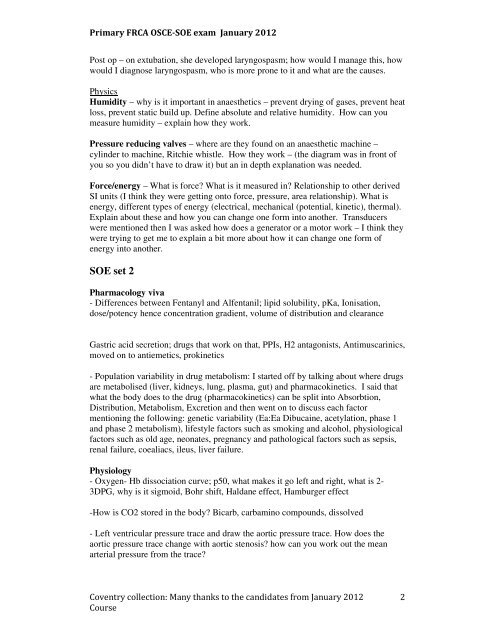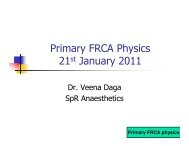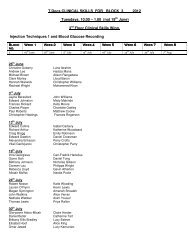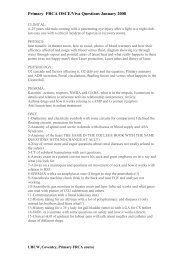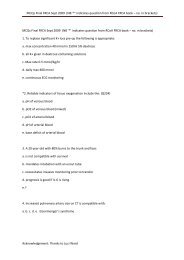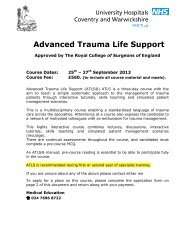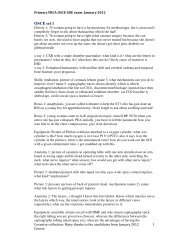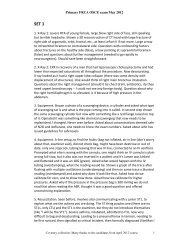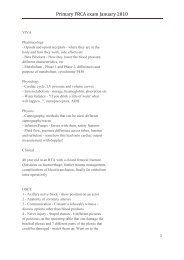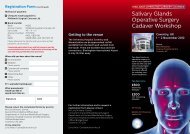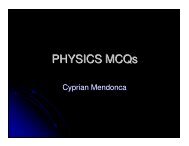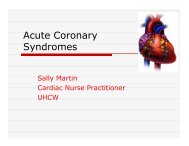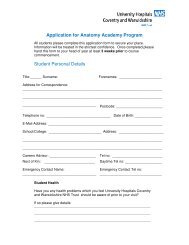Primary FRCA OSCE-SOE exam January 2012 Coventry collection ...
Primary FRCA OSCE-SOE exam January 2012 Coventry collection ...
Primary FRCA OSCE-SOE exam January 2012 Coventry collection ...
Create successful ePaper yourself
Turn your PDF publications into a flip-book with our unique Google optimized e-Paper software.
<strong>Primary</strong> <strong>FRCA</strong> <strong>OSCE</strong>-<strong>SOE</strong> <strong>exam</strong> <strong>January</strong> <strong>2012</strong><br />
Post op – on extubation, she developed laryngospasm; how would I manage this, how<br />
would I diagnose laryngospasm, who is more prone to it and what are the causes.<br />
Physics<br />
Humidity – why is it important in anaesthetics – prevent drying of gases, prevent heat<br />
loss, prevent static build up. Define absolute and relative humidity. How can you<br />
measure humidity – explain how they work.<br />
Pressure reducing valves – where are they found on an anaesthetic machine –<br />
cylinder to machine, Ritchie whistle. How they work – (the diagram was in front of<br />
you so you didn’t have to draw it) but an in depth explanation was needed.<br />
Force/energy – What is force? What is it measured in? Relationship to other derived<br />
SI units (I think they were getting onto force, pressure, area relationship). What is<br />
energy, different types of energy (electrical, mechanical (potential, kinetic), thermal).<br />
Explain about these and how you can change one form into another. Transducers<br />
were mentioned then I was asked how does a generator or a motor work – I think they<br />
were trying to get me to explain a bit more about how it can change one form of<br />
energy into another.<br />
<strong>SOE</strong> set 2<br />
Pharmacology viva<br />
- Differences between Fentanyl and Alfentanil; lipid solubility, pKa, Ionisation,<br />
dose/potency hence concentration gradient, volume of distribution and clearance<br />
Gastric acid secretion; drugs that work on that, PPIs, H2 antagonists, Antimuscarinics,<br />
moved on to antiemetics, prokinetics<br />
- Population variability in drug metabolism: I started off by talking about where drugs<br />
are metabolised (liver, kidneys, lung, plasma, gut) and pharmacokinetics. I said that<br />
what the body does to the drug (pharmacokinetics) can be split into Absorbtion,<br />
Distribution, Metabolism, Excretion and then went on to discuss each factor<br />
mentioning the following: genetic variability (Ea:Ea Dibucaine, acetylation, phase 1<br />
and phase 2 metabolism), lifestyle factors such as smoking and alcohol, physiological<br />
factors such as old age, neonates, pregnancy and pathological factors such as sepsis,<br />
renal failure, coealiacs, ileus, liver failure.<br />
Physiology<br />
- Oxygen- Hb dissociation curve; p50, what makes it go left and right, what is 2-<br />
3DPG, why is it sigmoid, Bohr shift, Haldane effect, Hamburger effect<br />
-How is CO2 stored in the body? Bicarb, carbamino compounds, dissolved<br />
- Left ventricular pressure trace and draw the aortic pressure trace. How does the<br />
aortic pressure trace change with aortic stenosis? how can you work out the mean<br />
arterial pressure from the trace?<br />
<strong>Coventry</strong> <strong>collection</strong>: Many thanks to the candidates from <strong>January</strong> <strong>2012</strong><br />
Course<br />
2


